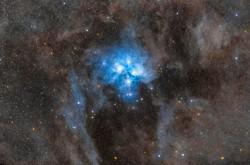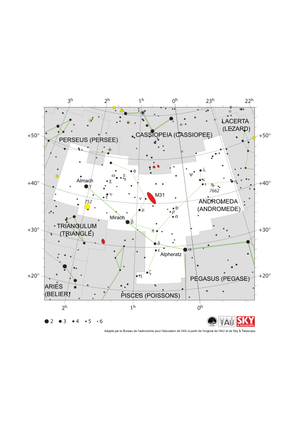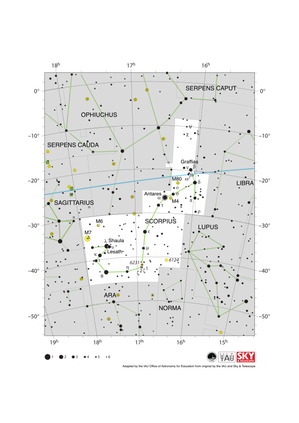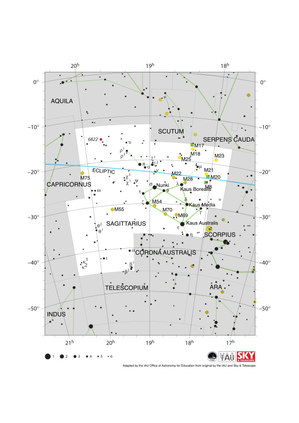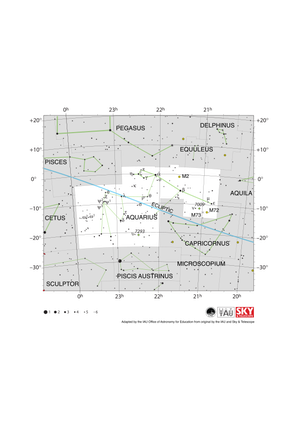Glossary term: Cluster ouvert
Description: Les amas ouverts sont des amas d'étoiles que l'on trouve dans notre Voie lactée et dans d'autres galaxies. On pense qu'ils sont le résultat d'un seul événement de formation d'étoiles et qu'ils peuvent être constitués de plusieurs centaines, voire de milliers d'étoiles. Les amas ouverts sont beaucoup moins étroitement liés à la gravitation que les amas globulaires et, dans la Voie lactée, ils se trouvent généralement dans le disque galactique. Cette faible liaison signifie qu'au cours de centaines de millions d'années, les amas ouverts se dissolvent progressivement dans la population stellaire générale de la Voie lactée. En tant que groupes d'étoiles ayant un âge commun, les amas ouverts constituent des laboratoires idéaux pour étudier l'évolution stellaire. Les Pléiades sont peut-être l'amas ouvert le plus célèbre du ciel.
Related Terms:
- Disque galactique
- Amas globulaire
- Voie lactée
- Amas d'étoiles
- Evolution stellaire
- Population stellaire
- Pléiades
See this term in other languages
Term and definition status: The original definition of this term in English have been approved by a research astronomer and a teacher The translation of this term and its definition is still awaiting approval
The OAE Multilingual Glossary is a project of the IAU Office of Astronomy for Education (OAE) in collaboration with the IAU Office of Astronomy Outreach (OAO). The terms and definitions were chosen, written and reviewed by a collective effort from the OAE, the OAE Centers and Nodes, the OAE National Astronomy Education Coordinators (NAECs) and other volunteers. You can find a full list of credits here. All glossary terms and their definitions are released under a Creative Commons CC BY-4.0 license and should be credited to "IAU OAE".
If you notice a factual or translation error in this glossary term or definition then please get in touch.
Related Media
The Pleiades M45 with Majestic Dust
Credit: Mohamed Usama/IAU OAE
License: CC-BY-4.0 Creative Commons Attribution 4.0 International (CC BY 4.0) icons
Related Diagrams
Carte de la constellation d'Andromède
Credit: Adapté par le Bureau de l'astronomie pour l'éducation de l'AIU à partir de l'original de l'AIU/Sky & Telescope
License: CC-BY-4.0 Creative Commons Attribution 4.0 International (CC BY 4.0) icons
Scorpius Constellation Map
Credit: Adapted by the IAU Office of Astronomy for Education from the original by IAU/Sky & Telescope
License: CC-BY-4.0 Creative Commons Attribution 4.0 International (CC BY 4.0) icons
Sagittarius Constellation Map
Credit: Adapted by the IAU Office of Astronomy for Education from the original by IAU/Sky & Telescope
License: CC-BY-4.0 Creative Commons Attribution 4.0 International (CC BY 4.0) icons
Aquarius Constellation Map
Credit: Adapted by the IAU Office of Astronomy for Education from the original by IAU/Sky & Telescope
License: CC-BY-4.0 Creative Commons Attribution 4.0 International (CC BY 4.0) icons
Crux Constellation Map
Credit: Adapted by the IAU Office of Astronomy for Education from the original by IAU/Sky & Telescope.
License: CC-BY-4.0 Creative Commons Attribution 4.0 International (CC BY 4.0) icons
